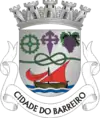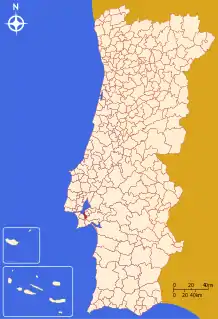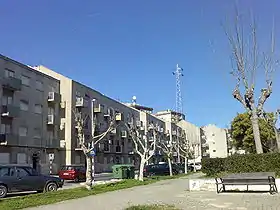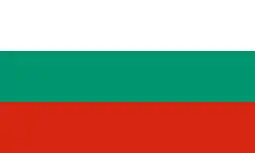Barreiro, Portugal
Barreiro (Portuguese pronunciation: [bɐˈʁɐjɾu] (![]() listen)) is a city and a municipality in Setúbal District in Portugal. The population in 2011 was 78,764,[1] in an area of 36.39 km².[2]
listen)) is a city and a municipality in Setúbal District in Portugal. The population in 2011 was 78,764,[1] in an area of 36.39 km².[2]
Barreiro | |
|---|---|
_(cropped).jpg.webp) _(cropped).jpg.webp) _(cropped).JPG.webp) .jpg.webp)  _(cropped).JPG.webp) | |
 Flag  Coat of arms | |
 | |
| Coordinates: 38°40′N 09°04′W | |
| Country | |
| Region | Lisboa |
| Metropolitan area | Lisbon |
| District | Setúbal |
| Parishes | 8 |
| Government | |
| • President | Frederico Rosa (PS) |
| Area | |
| • Total | 36.39 km2 (14.05 sq mi) |
| Population (2011) | |
| • Total | 78,764 |
| • Density | 2,200/km2 (5,600/sq mi) |
| Time zone | UTC±00:00 (WET) |
| • Summer (DST) | UTC+01:00 (WEST) |
| Local holiday | June 28 |
| Website | http://www.cm-barreiro.pt |
Barreiro has a view of the city of Lisbon from Avenida da Praia and a riverside area called Alburrica.
The mayor since 2017 has been Frederico Rosa, elected by the Socialist Party. The municipal holiday is June 28.
History
There are records of the village of Barreiro from as far as the 13th century, when the Military Order of Saint James of the Sword promoted its settlement. Due to the village's location, the main occupation of the population was harvesting salt and fishing.
By the time the Portuguese reached India and Brasil (early 16th century), it was in Barreiro that shipbuilding was concluded, since it started in Lisbon during summer and when the rougher weather arrived the construction had to be moved to somewhere with more sheltered conditions. It was also in Barreiro that the bread for the ships' crew was baked.[3] These activities put Barreiro on the map and in 1521 the village became a town.
In the 19th century, the railway lines from Setúbal and Vendas Novas were extended to Barreiro,[4] which alongside with the location by the Tagus made CUF select the town for the establishment of one of the biggest industrial estates of its time.[5] Quickly, thousands of people from all over the country arrived looking for work; a substantial amount of people migrated to Barreiro from the region of Alentejo, where rural workers had very few rights (work from sunrise to sunset and child labour were still normalised) but which was now well connected to Barreiro via the railway.
After the revolution that overthrew a 41 years long dictatorship, many factories were nationalised all over the country and so was the industrial estate in Barreiro. Without the former regime to restrict imports and control the national production, the business started to decline and the factories in Barreiro were gradually shut down.[6]
Also with the fall of the dictatorship, Portugal withdrew from the overseas territories and gave them their independence back. After the change in political powers abroad, thousands migrated to Portugal in order to flee violence; at this time Barreiro received many refugees, mostly from Portuguese and Angolan ethnic backgrounds. In autumn 1975 The New York Times profiled Barreiro as a "new home for refugees from Angola". [7]
Due to its industrial past, Barreiro residents have historically elected representatives from the Portuguese Communist Party in all local elections since the revolution (1976,[8] 1979,[9] 1982,[10] 1985,[11] 1989,[12] 1993,[13] 1997,[14] 2005,[15] 2009[16] and 2013[17]) except from the elections in 2001[18] and 2017,[19] won by the candidates from the Socialist Party.
In 1984 Barreiro became a city.[20]
Population

| Population growth (1801–2011) | |||||||||
|---|---|---|---|---|---|---|---|---|---|
| 1801 | 1849 | 1900 | 1930 | 1960 | 1981 | 1991 | 2001 | 2004 | 2011 |
| 2 425 | 3 384 | 7 738 | 21 030 | 35 088 | 88 052 | 85 768 | 79 012 | 78 992 | 78 764 |
Parishes
Administratively, the municipality is divided into 4 civil parishes (freguesias):[21]
- Alto do Seixalinho, Santo André e Verderena
- Barreiro e Lavradio
- Palhais e Coina
- Santo António da Charneca
Sports
- F.C. Barreirense is the local team and plays at Campo da Verderena. G.D. Fabril, another local team, plays at Complexo Desportivo Alfredo da Silva.
- José Augusto, Fernando Chalana, both Portugal international footballers were born in Barreiro.
- Bruno Martins Indi, footballer of Stoke City and the Netherlands national team was born in Barreiro to Bissau-Guinean parents.
Notable residents
- Leonor Andrade (b. 1994) – represented at the Eurovision Song Contest 2015
- Augusto Cabrita (1923–1993) – photographer, cinematographer and film director
International relations
Barreiro is twinned with:
 — Łódź in Poland (since 1996) [22]
— Łódź in Poland (since 1996) [22] — Stara Zagora in Bulgaria (since 1976)
— Stara Zagora in Bulgaria (since 1976)
References
- Instituto Nacional de Estatística
- "Áreas das freguesias, concelhos, distritos e país". Archived from the original on 2018-11-05. Retrieved 2018-11-05.
- https://associacaobarreiropatrimonio.pt/2019/02/10/barreiro-rectaguarda-logistica-da-expansao-portuguesa-seculos-xv-a-xvi/
- https://www.infraestruturasdeportugal.pt/pt-pt/centro-de-imprensa/160-anos-de-comboios-no-barreiro
- https://ensina.rtp.pt/artigo/cuf-barreiro-seculo-industria/
- https://www.jornaldenegocios.pt/weekend/detalhe/patrimonio-da-antiga-cuf-no-barreiro-vai-ser-classificado
- https://www.nytimes.com/1975/10/31/archives/for-angola-refugees-in-portugal-a-life-of-despair.html
- http://eleicoes.cne.pt/raster/index.cfm?dia=12&mes=12&ano=1976&eleicao=cm
- http://eleicoes.cne.pt/raster/index.cfm?dia=16&mes=12&ano=1979&eleicao=cm
- http://eleicoes.cne.pt/raster/index.cfm?dia=12&mes=12&ano=1982&eleicao=cm
- http://eleicoes.cne.pt/raster/index.cfm?dia=15&mes=12&ano=1985&eleicao=cm
- http://eleicoes.cne.pt/raster/index.cfm?dia=17&mes=12&ano=1989&eleicao=cm
- http://eleicoes.cne.pt/raster/index.cfm?dia=12&mes=12&ano=1993&eleicao=cm
- http://eleicoes.cne.pt/raster/index.cfm?dia=14&mes=12&ano=1997&eleicao=cm
- http://eleicoes.cne.pt/raster/index.cfm?dia=09&mes=10&ano=2005&eleicao=cm
- http://eleicoes.cne.pt/raster/index.cfm?dia=11&mes=10&ano=2009&eleicao=cm
- http://www.cne.pt/sites/default/files/dl/al_2013_mapa_resultados.pdf
- http://eleicoes.cne.pt/raster/index.cfm?dia=16&mes=12&ano=2001&eleicao=cm
- http://www.cne.pt/sites/default/files/dl/al2017_mapa_resultados.pdf
- https://dre.pt/web/guest/pesquisa/-/search/387340/details/maximized?serie_facet=I&filterEnd=1984-06-28&filterStart=1984-06-28&q=1984-06-28&tipo_facet=Lei&fqs=1984-06-28&perPage=50
- Diário da República. "Law nr. 11-A/2013, page 552 24" (pdf) (in Portuguese). Retrieved 17 July 2014.
- "Miasta partnerskie - Urząd Miasta Łodzi [via WaybackMachine.com]". City of Łódź (in Polish). Archived from the original on 24 June 2013. Retrieved 2013-07-21.